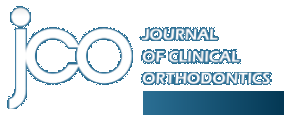Search Results For: 'case report'
2521.
From the Patient's Point of View
Volume 13 : Number 9 : Page 621 : Sep 1979
We practitioners often use clinical procedures which we have never experienced ourselves and our insight is via the literature and observation of patient reaction. Having recently undergone active ort...
2522.
Common Sense Mechanics, Part 3
Volume 13 : Number 11 : Page 762 : Nov 1979
(CONTINUED FROM PART 2) Static Equilibrium In spite of the fact that orthodontists have heard many times over that every action has an equal and opposite reaction, Newton's Third Law has not really be...
2523.
New Treatment Dimensions with First Phase Sectional and Progressive Edgewise Mechanics
Volume 14 : Number 9 : Page 607 : Sep 1980
This paper describes a proven procedure for distalizing maxillary buccal segments and arch leveling. In first phase treatment, sectional modules are inserted to produce unequaled first order mechanics...
2524.
Volume 15 : Number 8 : Page 565 : Aug 1981
Toward the end of active treatment, there is frequently a need for additional maxillary anterior intrusion (bite opening), space closure, and torque. Typically, the mandibular arch is essentially comp...
2525.
The Vari-Simplex Discipline, Part 1: Concept and Appliance Design
Volume 17 : Number 6 : Page 380 : Jun 1983
In my professional career, it has been a challenge to produce high-quality results in a large practice, using a relatively simple appliance technique. To accomplish this, an appliance has been designe...
2526.
Volume 19 : Number 8 : Page 570 : Aug 1985
The invisible retainer of Ponitz1 can be used either at the end of orthodontic treatment or as a transitional retainer between certain stages of treatment. For example, a phase of fixed appliance ther...
2527.
A Coordinate System for Model Storage
Volume 19 : Number 9 : Page 640 : Sep 1985
A coordinate system for model boxes provides attractive, accessible storage within a minimal amount of office space (Fig. 1). New models can be entered, old models purged, and the system expanded with...
2528.
Volume 20 : Number 9 : Page 0 : Sep 1986
After a practice has been operating for many years, orthodontists begin accumulating a number of paid-up patients who still require additional treatment. The practitioner usually absorbs this addition...
2529.
Video Printing in Orthodontic Photography
Volume 21 : Number 2 : Page 0 : Feb 1987
Immediate, low-cost black-and-white pictures can now be made with a video printer that is ideal for orthodontic records. The Mitsubishi P50U Video Printer measures about 4" x 8" x 14", weighs less tha...
2530.
A System for Retracting Canine Roots
Volume 21 : Number 6 : Page 0 : Jun 1987
If a force is applied to the crown of a tooth, it produces a rotational moment that tends to tip the tooth. Further, a force applied to a bracket on the buccal side produces another, weaker moment tha...
2531.
Volume 23 : Number 3 : Page 0 : Mar 1989
Splints are designed to accomplish specific therapeutic objectives and should usually be used for short periods of time (see Part 9, JCO, February 1989). Other considerations may necessitate that a re...
2532.
Assessment of Mesiodistal Axial Inclination through Panoramic Radiography
Volume 24 : Number 3 : Page 0 : Mar 1990
A major objective of orthodontic treatment is the normalization of tooth positions in three planes of space, with the goal of approaching predefined cephalometric or occlusal standards.1-7 One of the ...
2533.
THE EDITOR'S CORNER
Volume 26 : Number 1 : Page 0 : Jan 1992
Futile Subtraction A few months ago, a good friend told me about a colleague's decision to control his personnel costs by dismissing his entire staff and replacing them with less experienced and less ...
2534.
Volume 26 : Number 4 : Page 0 : Apr 1992
The skeletal Class III malocclusion is characterized by mandibular prognathism, maxillary deficiency, or both.1,2 Such a patient has a retrusive nasomaxillary area and a prominent lower third of the f...
2535.
MANAGEMENT & MARKETING
The Dilemma of Practice Transition
Volume 27 : Number 2 : Page 0 : Feb 1993
The following article, by Dr. Ron Cooper and his financial advisor, Jon Shuler, effectively highlights what all of us have been told over and over again from the beginning of our practice lives: If yo...
2536.
Early Class III Treatment with Magnetic Appliances
Volume 27 : Number 10 : Page 0 : Oct 1993
Various methods, including the Delaire face mask, the chin cup, the Class III activator, and Class III mechanics with fixed appliances, are used to correct skeletal Class III malocclusions,1-6 which a...
2537.
Volume 28 : Number 3 : Page 0 : Mar 1994
1. Do you treat patients in your practice who require TMJ treatment only? If so, what percentage of your active cases are they? Exactly half of the respondents reported treating patients for temporoma...
2538.
Volume 28 : Number 9 : Page 0 : Sep 1994
1. How do you define mild, moderate, and severe anchorage problems? Most of the clinicians based their definition on a combination of factors, including crowding, overjet, molar relationship, and inci...
2539.
THE EDITOR'S CORNER
Can We Manage Without Managed Health Care?
Volume 28 : Number 10 : Page 0 : Oct 1994
Can We Manage Without Managed Health Care? Proponents of national universal health-care schemes point out that the United States is the only nation in the Western world that does not have such a progr...
2540.
Recognition and Empowerment: An Effective Approach to Enlisting Patient Cooperation
Volume 29 : Number 1 : Page 0 : Jan 1995
Few health-care disciplines demand as much patient cooperation as is required for successful orthodontics. Retention of appliances on the teeth depends to a large extent on the patient's agreement to ...
Showing 2521-2540 of 3241 results. Search completed in 0.16 seconds.

